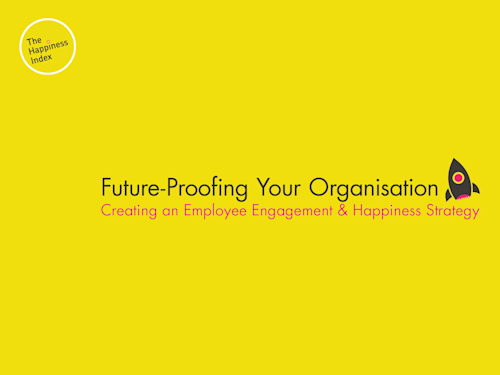
Creating an Employee Engagement AND Happiness Strategy
Anonymous feedback is just what it sounds like - feedback that cannot be traced back to an individual. It’s particularly important for HR and People functions in the workplace because it means that your people can provide feedback without fear of the consequences.
Collecting anonymous feedback will build trust and psychological safety within your organisation. The results will allow you to create meaningful action plans, tailored to what your people actually need and want. Both of these elements will lead to happier and more engaged employees, as well as improved business outcomes.
There are two types of anonymous feedback. The first is feedback which can’t be tied back to individuals but does include contextual information. For example, you may ask for information about the respondent’s job role, tenure, team, department or location. This kind of information will help you respond appropriately and create highly-targeted programmes to address any problems uncovered. However, people may feel apprehensive that their feedback will be traced back to them.
Our happiness and engagement platform can help with this. We handle all the data processing, meaning that employees can rest assured that no one within their organisation has access to their feedback. We have a minimum threshold for releasing the data. This means that when you drill into the data - for example by team or job function - you won’t see the feedback unless there are more than five responses. This makes it near-impossible for individuals to be identified.
The second type is completely anonymous with no identifying data. Your people will feel they’re able to comment on particularly personal or sensitive matters. You will likely get very candid feedback. However, because of this, there’s no particular context around the feedback and you cannot tie it back to particular groups, departments or job functions.
Our Employee Voice survey captures this kind of feedback. Since each organisation only has one generic employee voice link, there is no way to trace any feedback back to the source. This guarantees anonymity to everyone in your organisation.
Ideally your feedback programme will combine both types. Both have strengths and benefits, so having a blended approach will allow you to maximise the impact of your programme.
If you have gathered supporting information, then it is easier to maintain context to feedback. You will be able to spot trends and themes between teams, employee lifecycle stages and locations. This will help you to generate a robust strategy that supports your team.
Our platform can help with the aid of easy-to-understand dashboards and downloadable reports. These tools mean that results can be easily gathered, analysed and shared with key stakeholders. This will allow you to quickly move to targeted action planning.
With completely anonymous feedback, it can be harder to maintain context. Not only do you have no supporting data but you may also find you get more comments.
Our platform helps support you in two ways. Firstly, we use cutting edge AI and sentiment analysis tools to help you look at your comments by theme and intent. This saves you time and allows you to identify strengths and weaknesses within your organisation’s culture. Secondly, we can help you benchmark and trend your data over time. This means that you can start to identify patterns within your feedback that might be linked to seasonal internal pressures or macro world events externally.
As with any feedback, it’s important to respond to anonymous feedback. This will help build trust within your organisation. If your team doesn’t think there’s any action happening off the back of the feedback they provide, they will stop responding to your programme. This will erode trust in your organisation and will leave you without a useful stream of data.
Our neuroscience model shows us that feedback is an important component of our need for acknowledgement. Responding to feedback can also build trust in those who were previously apprehensive about the programme or the impact of their voice. Sometimes it's a journey. Initially response rates may be low, but don’t be put off - this is something to build on. As you continue to respond to feedback, you’ll find this will improve.
Another factor to consider is that employee feedback often happens in cycles. Initially you may find you’re receiving overwhelmingly negative or unconstructive feedback. If you stay the course and respond to your people with ideas, further questions and supportive language, you will find you get increasingly more positive and constructive comments. It’s easy to give up while your people are still getting to grips with a new programme, but by doing this you may lose out in the long run.
Not all feedback is negative feedback. At The Happiness Index we encourage people using our platform to celebrate their successes and achievements and praise initiatives, programmes or individuals. By sharing these wins, you will be able to encourage others to come up with the next winning idea!
It might seem like it’s hard to respond to anonymous feedback without compromising anonymity. However, this is where our platform really comes into its own.
Firstly, our Employee Voice programme gives you the option to turn on a feedback functionality. We call this Closing The Feedback Loop. Your people can choose to leave their email alongside their comments. This means that they can receive replies to their feedback straight to their emails through our platform. No one within your organisation will be able to see their email address, meaning anonymity is maintained. However, your team will be able to respond directly to their concerns.
Another option is to group feedback by theme. For example, if you notice a number of people becoming frustrated with a particularly long team meeting, or appreciation for your finance team’s speedy handling of an invoicing issue - then these can be addressed together to protect anonymity.
It may be that because the feedback has been given anonymously you don’t have enough detail to respond to the feedback thoroughly. If this is the case, there’s no reason why you shouldn’t raise the feedback within a group setting, meeting or a team-wide email, explaining that you would like to provide a resolution but that you need more information. This should always be done alongside reassurance that there will be no negative consequences.
If you have noticed a pattern of feedback but you don’t have enough information to act on it specifically, you may need to dive deeper into the area. For example, if you notice that your team is struggling with their wellbeing, you may want to follow up with another survey that will give you more information. We have a wide range of pre-built employee surveys based on neuroscience which can help support this activity.
There are occasions when feedback doesn’t require direct action - people may want to feel listened to or get something off their chest. This encourages a connected and transparent workforce. When you suspect this is the case, you should still acknowledge the feedback publicly. This will drive a wider feedback culture where people also feel comfortable giving feedback in person.
The best way to respond to feedback (whether it’s anonymous or not) is through action. It may be enough to say that you’ve identified an issue with X and you will be addressing it by implementing Y. You may not be able to resolve the problem right away for whatever reason but you should be able to tell your team timelines for corrective initiatives. This is how you build trust and buy-in for feedback programmes.

Linked to Happiness & Engagement in our neuroscience methodology... learn more
The Happiness Index helps organisations measure the key employee engagement AND happiness drivers to power their people strategy.
Our unique platform offers the products, insights and tools to shine a light on your cultural health and empower management to drive thriving cultures.
Our neuroscience-based pre-built surveys measure the full employee experience - from onboarding to exit to empower and enable organisations to understand their people and create data-led action plans.
